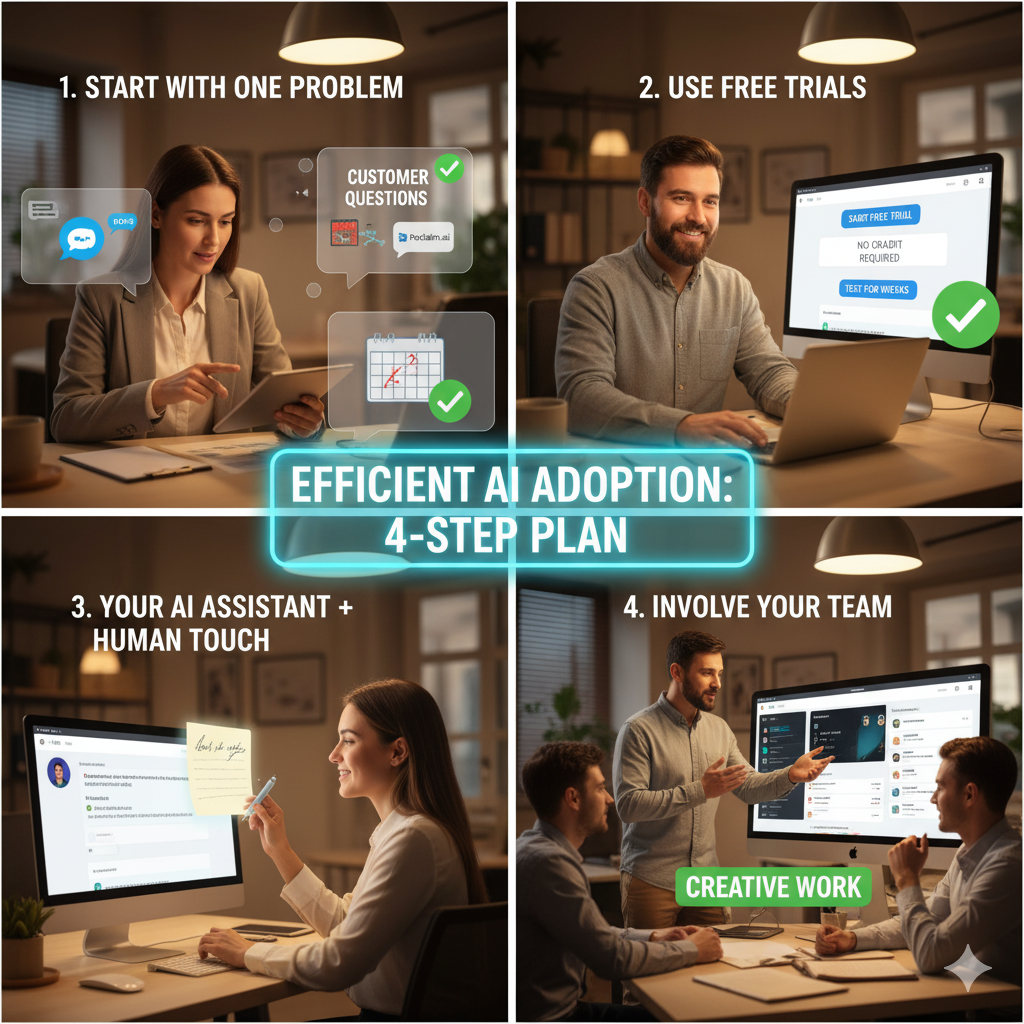hey guy’s i tried the podcast version of this blog using ai listen to it if you are interested.
It’s 2025, and AI tools are everywhere. Yet many business owners still feel left out. Why? Because we often believe AI is too complex, too costly, or only for tech experts. In reality, that’s a myth. Today, AI is no longer a luxury—it’s an affordable, accessible tool that can help businesses of all sizes grow faster. Whether you run a local general store or lead a multinational corporation, AI can streamline your operations and give you a competitive edge.
In this article, we’ll break down the top 5 AI tools that any business owner, regardless of their technical expertise, can implement right away. We’ll show you how these simple, accessible tools can save you time, boost efficiency, and help you grow, ensuring you don’t miss out on the opportunities AI has to offer.

1: 5 AI Tools for Your Small Business (No Tech Skills Needed)
Forget the tools you’ve heard about before. These five AI tools are practical, affordable, and perfect for real-world business problems. They’re designed to be a personal assistant you never knew you needed.
Grammarly for Professional Communication
- What it does: This AI tool acts as your personal editor. It corrects spelling and grammar, and even helps improve the clarity and tone of your writing.
- Best for: Any business that communicates with customers, suppliers, or employees via email, social media, or reports.
- Why it helps: You don’t have to worry about typos or sounding unprofessional. Grammarly gives you confidence in every email you send, which builds trust with your audience.
HubSpot AI for Marketing and Sales
What it does: HubSpot has built-in AI features that can write email subject lines, analyze customer data to suggest sales leads, and create short-form marketing content.
Best for: Businesses looking to improve their marketing and sales efforts without hiring a huge team.
Why it helps: It’s an all-in-one platform that uses AI to automate repetitive tasks, like sending follow-up emails, and provides insights into what your customers actually want. It’s a great way to save time and make smarter decisions.

3. Tidio for Customer Service
- What it does: Tidio is an AI-powered chatbot that can be installed on your website in minutes. It can answer common questions from customers 24/7, qualify leads, and even handle simple order queries.
- Best for: E-commerce stores, service-based businesses, or any company that gets a lot of basic questions from visitors.
- Why it helps: This tool saves you from answering the same questions over and over again. It gives your customers instant help, even when you’re not there, which improves satisfaction and can lead to more sales.
4. Descript for Content Creation
- What it does: Descript is a tool that lets you edit video and audio by simply editing the text transcript. It also automatically removes filler words like “uh” or “um” and transcribes conversations.
- Best for: Anyone who creates video or podcast content for their business, from a real estate agent making property tours to a business coach sharing tips.
- Why it helps: It takes the pain out of video editing. Instead of spending hours learning complex software, you can edit a video as easily as you edit a document.
5. Reclaim.ai for Time Management
- What it does: This is an intelligent calendar assistant. You give it your to-do list, and it automatically finds time in your calendar for your tasks and important meetings.
- Best for: Overwhelmed business owners, freelancers, and project managers.
- Why it helps: It ensures you don’t just react to what’s urgent. It protects time for your most important work, like strategizing or planning, so you can stop feeling like you’re always busy but not productive.
2: Your Step-by-Step Guide to Using These AI Tools Efficiently
The biggest mistake a new user can make is trying to do too much at once. To use these tools efficiently, follow a simple, four-step plan:
- Start with One Problem. Instead of trying to automate everything, pick your most annoying, repetitive task. Is it answering customer questions? Go with Tidio. Is it scheduling your day? Try Reclaim.ai. This gives you a quick, satisfying win.
- Use Free Trials. All of the tools mentioned offer a free trial or a free tier. Don’t pay a single rupee until you’ve tested the tool for a few weeks to make sure it solves your problem.
- Think of it as Your Assistant. These tools are here to help you, not replace you. Your job is to check the AI’s work and provide the human touch that only you can. For example, a chatbot might answer a basic question, but a human can follow up with a personal touch.
- Involve Your Team. If you have employees, get their buy-in. Explain how the AI tool will make their jobs easier by handling boring tasks, allowing them to focus on more creative and important work.

3: What to Automate First? The Smartest Way to Start with AI tools
When you have a limited budget and even less time, you need to prioritize. Here’s a list of which problems to solve first:
- Priority 1: Repetitive Communication. Tasks like answering FAQ emails or writing basic social media posts are the lowest-hanging fruit. They are predictable and easy to automate. Using tools like Tidio or HubSpot can save you hours a week.
- Priority 2: Time-Consuming Operations. Once you have a handle on communications, look at your internal processes. Do you spend hours on meeting notes? Use Descript. Are you constantly fighting to find time for your work? Reclaim.ai is your best bet.
- Priority 3: Marketing and Content. This is an ongoing process. Once you’ve automated the urgent stuff, you can use tools like HubSpot to create a steady stream of content that brings new customers to your business.
4: Real Stories: How Small Businesses Are Winning with AI tools
The real proof of AI’s power isn’t in a tech article; it’s in the stories of people just like you. These aren’t massive companies with unlimited budgets; they are small businesses and solo entrepreneurs who used simple, affordable tools to solve specific problems and see real results.

Case Study 1: The Small Business That Saved Hundreds of Hours a Month
An award-winning UK mattress retailer, Mattress Next Day, was spending hundreds of hours a month on customer support. Their team was overwhelmed with repetitive questions, which meant less time for sales and personalized service. They decided to implement Tidio’s AI-powered chatbot.
- The Result: The AI chatbot answered a significant portion of customer queries instantly, freeing up their team to focus on more complex tasks. This led to saving over 400 hours monthly on customer support, allowing them to deliver faster responses and maintain exceptional service standards. You can read more about their success on the Tidio blog.
Case Study 2: The Small Firm That Increased Leads by 216%
FBA, a financial services business, was looking for a more efficient way to generate leads and boost their content creation. They were using a standard sales and marketing approach, but it was time-consuming and not as effective as they wanted. They began using HubSpot’s AI tools.
- The Result: After adopting HubSpot’s AI, FBA was able to increase content production by 250% and improve lead generation by 216%. This powerful combination of automation and smarter content creation led to a 63% revenue boost. This case study shows how AI isn’t just for saving time—it’s for accelerating growth. You can see how they achieved this on the HubSpot case studies page.
Case Study 3: The B2B Company That Cut Video Production Time by 70%
Cloudinary, a B2B company, was creating a lot of video content for customer training but found the production process slow and inefficient. They needed a way to produce high-quality videos without a huge team or a lot of time. They started using Descripts AI editing software.
- The Result: With Descript’s text-based editing, Cloudinary was able to dramatically cut their video production time by 70%. This allowed them to produce more training content in less time, helping their customers learn faster and improving overall support. This shows how AI can streamline a creative process, not just a data-heavy one. Learn more on Descript’s customer stories page.
hey guy’s i tried the podcast version of this blog using ai listen to it if you are interested.

